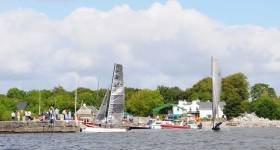Displaying items by tag: Corrib Rowing and Yachting Club
Galway Boating Clubs Unite For Historic Cong-Galway Sailing Race Across Lough Corrib This June
Sailors and boating enthusiasts from Galway’s sailing and boating clubs are coming together next month to follow their forebears in Europe’s oldest and longest inland sailing race.
On Saturday 29 June the fleet of dinghies will pit their wits against the elements and each other on the historic route along the length of Lough Corrib from Lisloughrey near Cong to Galway city.
Since 1882, sailors have raced the length of Lough Corrib. While the origin of the wager which prompted the first races is shrouded in myth and lore, the early races were hotly contested and a great social occasion.
They were very much a test of stamina as well as skill, with competitors completing a round trip of over 60 nautical miles from Galway to Ashford Castle and back again. It was raced annually until 1914 and the outbreak of World War I.
The race was revived in its current format, sailed in one direction from Lisloughrey to Galway, in 1972 and again became a stable in the Galway maritime calendar.
However, the weather gods have not been good to the race in recent years.
So, to ensure a successful event this year, the boating and sailing clubs around Galway have come together and moved the event to an earlier slot in the calendar.
It will take place this year on 29 June and follow the traditional steamer channel through the lake.
Full details of the race and the online registration are available on the Galway Bay Sailing Club website.
Transport will leave Corrib Rowing and Yacht Club and the Galway Commercial Boat Club at 8am to bring sailors to the start line in Lisloughrey. From there, the boats will make their way to Kilbeg for lunch and then continue on to the finish line in the lower Corrib.
However, the challenges don’t end there, with the Quincentennial Bridge providing a final obstacle to be negotiated — usually with the mast, sails and sailors in the water!
Following the race, there will be the chance to relive the decisive moments of the race at a reception hosted by the Commercial club after the historical silverware has been presented at CRYC.
Galway Bay Sailing Club has a link to the Notice of Race and Sailing Instructions, as well as the online registration form. For more details about the 2019 Cong-Galway Sailing Race, see the Facebook event page HERE.
Corrib Rowing and Yachting Club
Welcome to the CRYC web site which we hope will be of interest to members and visitors alike. Established in 1864, the CRYC is one of the oldest inland waterway clubs in the British Isles. Located in the centre of Galway City it continues to provide facilities for water-based recreational activity for almost 300 members.
Corrib Rowing & Yachting Club, Earls’ Island, Distillery Road, Newcastle, Galway. Tel: 091 564560, email: [email protected]
(Details courtesy of Corrib Rowing & Yachting Club)
Have we got your club details? Click here to get involved
























































